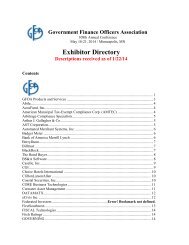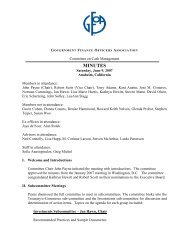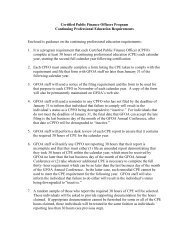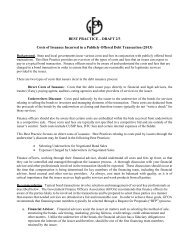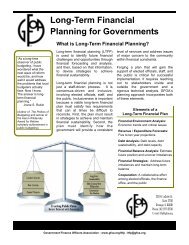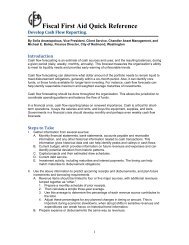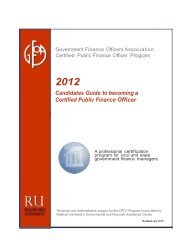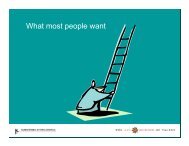C Coaching Your Team To Effective Leadership
C Coaching Your Team To Effective Leadership
C Coaching Your Team To Effective Leadership
You also want an ePaper? Increase the reach of your titles
YUMPU automatically turns print PDFs into web optimized ePapers that Google loves.
least as essential to personal and organizational<br />
success as technical skills.<br />
Leaders must be capable of influencing<br />
the people who report to them, other<br />
managers, higher-ups, other members of<br />
the community — the list is endless.<br />
Interpersonal savvy also requires selfawareness,<br />
a personal, implicit understanding<br />
of one’s strengths and weaknesses.<br />
Leaders must be willing to see<br />
the things in themselves that need to be<br />
changed, realize how these blind spots<br />
and biases affect their perceptions and<br />
decision making, and then set about<br />
changing them. Self-awareness allows<br />
people to make themselves better.<br />
Making It Happen. Leaders have a<br />
reputation of doing what they say they<br />
will do. This is the evidence, the proof,<br />
and the baseline for trust and credibility.<br />
Someone who does not get the<br />
work done does not have credibility as<br />
a professional.<br />
At the same time,the occasional spot<br />
of incompetence is not necessarily a<br />
bad thing. People need to take risks,<br />
learn new skills, try new things, or start<br />
new jobs.The important thing is to keep<br />
a firm grasp on one’s limitations and<br />
acknowledge them. People who are<br />
expanding their abilities or making<br />
transitions can avoid damaging their<br />
credibility by being careful about making<br />
promises regarding new areas of<br />
expertise.<br />
Humility. Leaders do not harbor a<br />
desire to shine beyond all others. A<br />
leader must be willing to point out the<br />
direction of future success and then get<br />
out of the way so those who have the<br />
skills and abilities can accomplish the<br />
goal. A desire for stardom will only<br />
thwart this essential goal. A big ego is<br />
dangerous in a position of leadership.<br />
Having some fun. Humor, creativity,<br />
and fun are both allowed and encouraged.<br />
While leadership is often serious<br />
business, a leader who has a sense of<br />
humor and fun fosters an environment<br />
of innovation and creativity. Serious<br />
times require serious behavior, but not<br />
all times are serious, and joy should be<br />
as much a part of leadership as focus<br />
and discipline.<br />
ENCOURAGING LEADERSHIP<br />
The best way to encourage leadership<br />
in one’s organization is to model leadership<br />
characteristics. As the old saying<br />
goes, “a leader leads by example,<br />
whether he intends to or not.”If employees<br />
are to learn about leadership, they<br />
need to see the right attributes mirrored<br />
in the behaviors, attitudes, and procedures<br />
of the organization.<br />
Helping others become leaders<br />
requires coaching, and lots of it. Since<br />
leadership behaviors are not tactical<br />
skills, there is no one, obvious way to<br />
proceed. Remember that there are multiple<br />
ways to be an effective leader, and<br />
watch for opportunities to learn from<br />
those you are trying to teach.<br />
Informal <strong>Coaching</strong>. We provide<br />
informal coaching to everyone we<br />
come in contact with,every day.The way<br />
we greet people,engage in dialogue,ask<br />
questions, and listen to answers, all provide<br />
insights and feedback to the people<br />
we interact with. For example, our<br />
biases play out in every conversation,so<br />
we need to be mindful of those preferences<br />
and preconceptions.<br />
One excellent informal coaching<br />
method is to catch people doing something<br />
right, then acknowledge and<br />
encourage the behavior. When an<br />
employee influences others by asking<br />
open-ended questions that further the<br />
discussion, acknowledge a job well<br />
done. When someone appropriately<br />
inserts humor into a meeting, show<br />
approval by laughing along with everyone<br />
else. Small acknowledgements of a<br />
job well done do not go unnoticed, nor<br />
do disapproving looks or lack of eye<br />
contact. <strong>To</strong> ensure that good behaviors<br />
will continue, leaders need to show<br />
employees that they saw the behavior,<br />
liked it, and want to see it again.<br />
Informal coaching takes place many<br />
times every day — during a chat in the<br />
hall, a meeting, a planning session, and<br />
so on. <strong>Coaching</strong> takes place during<br />
every contact with employees.<br />
Therefore,we need to be mindful of our<br />
intent, the messages we send, and the<br />
behaviors we encourage. Even seemingly<br />
subtle actions send a message.For<br />
example, one leader — who had a reputation<br />
for being an outstanding leader<br />
and mentor — sat in the center of the<br />
first row to show support for those who<br />
had worked hard to make presentations<br />
at a large department meeting.This was<br />
a thoughtful behavior, and the intent<br />
was spot on. But when this person was<br />
not sitting in the front row during one of<br />
the presentations,everyone got the message<br />
that this presentation was not<br />
important. The leader was actually sitting<br />
at back of the room, paying close<br />
attention,but few people noticed.Those<br />
who are in leadership roles are<br />
watched closely at all times.<br />
Formal <strong>Coaching</strong>. The best way to<br />
help employees develop their leadership<br />
skills is to combine informal and<br />
formal coaching. One formal coaching<br />
technique is to create an assessment of<br />
the characteristics defining effective<br />
leadership for employees to complete,<br />
incorporating their thoughts and feed-<br />
February 2009 | Government Finance Review 57



